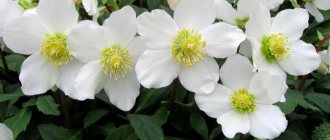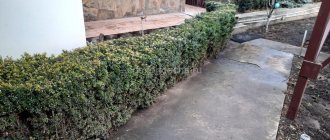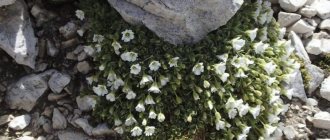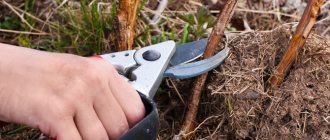In our country, clematis are no longer a novelty and are often found on plots. This profusely blooming vine has won more than one heart. In central Russia and the southern regions, clematis feels good and requires minimal care over the summer. But one cannot say that he is so unpretentious! To get a luxurious liana, you need to know the timing and rules for planting clematis in open ground in the spring and caring for the flower.
1. Characteristics of clematis 2. Planting dates 3. Choosing a place for planting 4. How to make a planting hole 5. How to plant clematis 6. Caring for clematis in the spring 6.1. Feeding 6.2. Garter and pruning 7. Reproduction 8. Diseases and pests
Photo: The plant requires a lot of attention from the gardener, but it is worth growing it on your site!
Description of clematis
Clematis (clematis) is a perennial herbaceous vine from the Ranunculaceae family. Grows in subtropical and temperate climate zones.
- The shoots are curly, sometimes straight.
- Flowering occurs in spring or early summer.
- The flowers are large, and in some species inflorescences are formed.
- They were brought to Russia back in the 19th century and were grown only in greenhouses. Then they gradually began to create hybrids, which now decorate almost every garden.
- There are varieties that do not need shelter for the winter, but most varieties have low winter hardiness and must be “insulated” before winter.
Photo: The plant begins to bloom in spring or early summer.
Features of care by group
The distribution of care among groups is determined by pruning conditions, which is associated with flowering characteristics that differ for different species.
Group A
In the varieties included in the group, flowers are formed on the shoots of the previous year:
- Alpina;
- Montana;
- Florida.
Care for clematis according to the following rules:
- Clematis Alpina
Representatives of this group are sometimes grown, excluding pruning from the stages of care, or after flowering, the part of the shoot on which the flowers were located is removed. - The generative part of the bush before sheltering before wintering should be removed according to the rules of moderate pruning; Damaged or weak shoots are also removed.
- The remaining above-ground part of the vine must be reliably protected from frost , especially if there are large buds on it, otherwise the buds will freeze. To do this, the remaining shoots are rolled up and laid in such a way that they do not adhere to the ground (for this purpose, flooring made of spruce branches is used).
Group B
Varieties included in the Lanuginosa and Patens groups, which are distinguished by the growth of flowers on the shoots of both the current and the previous year.
Clematis Patens
It is worth caring for them based on the fact that flowering has two stages:
- early - on shoots of the previous year;
- later - on the shoots of the current year.
Care differs in that pruning, as well as flowering, is carried out in two stages:
- In the summer, after the end of the first flowering, the generative part of the bush formed by the shoots of the previous year is eliminated.
- When preparing the bush for winter shelter, shoots of the current year are eliminated in the fall.
Group C
In the varieties included in the group, flowers appear only on the shoots of the current year:
- Clematis Jacqueline
Jacqueline, - Viticella,
- Integrifolia,
- Burning
- Tangut.
Closer to winter, “pruning at the root” or to the level of the first leaf is undertaken. On the eve of winter, hilling is necessary.
If you have never grown clematis before, Group C varieties are the best option because they are easier to care for: they require minimal preparation for winter and are resistant to weather conditions.
When to plant clematis (clematis) in spring
Clematis are planted in spring or autumn. And seedlings with a closed root system can be planted all summer. It is recommended to plant many varieties in the spring so that they have time to build up their root system and prepare for the upcoming winter.
| Note. A big plus of planting clematis in the spring is that over the summer the plant has time to get used to the new place and grow roots. |
But there is one nuance in spring planting - you need to have time to plant clematis with an open root system within a certain period of time. The plant's growing season begins quite early.
Planting clematis with half-opened buds and an open root system is fraught with unpleasant consequences, since the plant will instantly react to the slightest damage to the roots during planting. It is necessary to plant in open ground only with unopened buds. Or with those that have just begun to swell.
| On a note. Clematis, which are sold in pots (with a closed root system), can be planted even with leaves as soon as the return frosts have ended. |
The timing of planting clematis in each region will depend on weather conditions and the condition of the planting material. As a rule, this is April–May. Somewhere you can plant it already in April. Northern regions can plant starting from the second half of May. If a seedling has a poorly developed root system, then it is better to postpone planting it in open ground - plant it in a pot or greenhouse and grow it there.
In the first year after planting, clematis may “want” to bloom. You don't need to let them do this. As soon as we notice the buds, we tear them off without sparing. You can leave one flower to see if you have the right variety. But this will weaken the plant a little. In the first year, you need to let the plant grow a good root system and get used to the place.
Photo: You need to plant the flower before the buds bloom.
Botanical characteristics worth knowing
Clematis can be shrubs or herbaceous perennials, but most varieties and species are woody summer-green vines. Garden clematis reach a height of 1 to 3–4 m; species, such as mountain clematis (Clematis montana) and grape-leaved clematis (C. vitalba), can grow up to 10 m.
Clematis montana 'Pink Perfection'
The stem of clematis consists of internodes, each of which ends in a node with a pair of buds located opposite in the axils of the leaves. Buds are divided into vegetative, generative (flowering) and mixed. Clematis has dormant buds on the lower part of the stems and on the roots, which awaken when the shoots die. Therefore, if the above-ground part of the plant has died, do not rush to dig up the roots and plant something else in this place. Wait. A year or two will pass and... lo and behold! A young, healthy shoot will grow in place of the dead plant.
The leaves of different varieties are also different: simple, pinnate, trifoliate.
Their petioles are mobile and, twisting around the support, hold the plant in an upright position. The clematis flower does not have petals; we take them to be colored petal-shaped sepals, which form a simple perianth. Usually there are 4-8 sepals, in double varieties ( 'Daniel Deronda' , 'Purpurea Plena Elegance' , 'Terry' and others) their number can reach up to 70.
Clematis 'Purpurea Plena Elegans'
In the center of the flower there are many pistils, surrounded by many stamens, which consist of a filament and anthers. Brightly colored, they enhance the decorative effect of the flower and help in determining the variety. In clematis, which bloom in spring and early summer, the flowers are larger during the first flowering, and in some varieties they are double; when flowering again, they are smaller and simpler. The color of the sepals also changes - towards the end of flowering it turns pale, and its intensity depends on weather and soil conditions.
Clematis 'Gypsy Queen'
According to the shape and arrangement of sepals in large-flowered clematis, several types of flowers are distinguished:
- star-shaped – the sepals are narrow and touch only at the base ( “Kuba” , “Meeli” );
- cross-shaped - the sepals themselves are relatively wide, in the lower part they are very narrow, distant from each other, usually there are 4-6 of them ( 'Jackmany' , 'Gypsy Queen' );
- disc-shaped – the sepals are wide, strongly overlapping each other ( 'Ville de Lyon' ).
Clematis 'Ville de Lyon'
How to choose a place to plant clematis in the spring
The choice of location for clematis seedlings with open and closed root systems is the same.
The apical shoots of the plant should be in the sun, and the lower part should be in the shade. Shading protects the roots from overheating and rapid drying out of the soil. To provide shade at the feet, you can plant low plants next to them, which will cover the lower part of the flower with their foliage. It can be hosta, annual flowers, low perennials.
- We select a place protected from strong winds. Most often, clematis are planted along the fence or near the wall of buildings.
- If the plant is planted near a building, then we calculate such a distance so that streams of water do not flow onto it during rain. It is advisable to retreat at least 70 cm from the building. But it’s better to step back a meter or one and a half.
- The plant needs strong, solid support on which it will climb.
- The plant does not like stagnant moisture in the soil and strong fogs in the morning. Therefore, it should not be planted in lowlands and where groundwater flows close to the surface of the earth.
- The soil can be anything. Clematis is unpretentious in this regard. But it is best to choose neutral soil. The plant does not like acidic soil, so when planting, deoxidize the soil in the planting hole by adding wood ash or dolomite flour.
Photo: The flower needs to be provided with support along which it will curl.
Suitable varieties
Many varieties that are frost-resistant and highly decorative are successfully grown in Siberia.
Elegy
Purple beauties with a flower size of up to 13 centimeters. Shoots grow up to 3.5 meters. It has been cultivated in Siberia for many years.
Luther Burbank
The Luther Burbank variety is not afraid of frost and blooms throughout the summer months. The flowers are purple-violet with yellow anthers (16-20 centimeters).
A strong bush (1-1.5 meters) does not need support, it is strewn with blue flowers with delicate veins.
The president
A star-shaped flower with wavy petals. Flowering - twice a season, the color of the flowers can change from dark to light purple.
Multi Blue
Lush double flowers with colors ranging from purple to blue and up to 20 centimeters in size. In the absence of early frosts, the bush may bloom again in the fall.
Miss Bateman
White and delicate, like the English Miss, the flowers grow up to 15-17 centimeters. Grown in Siberia due to its unpretentiousness and resistance to adverse conditions.
Cholmondeley
Clematis of this variety produces flowers in shades from lilac to purple. On old shoots they are semi-double, on young shoots they are simple.
Dr. Ruppel
Exquisitely shaped and colored flowers with lush anthers. The petals are soft pink with a brighter stripe in the center.
Symptoms and treatment of clematis diseases, causes and how to get rid of themRead
Nellie Moser
Star-shaped flowers with 6-8 petals with pointed tips. The color of the petals is light pink with a bright purple stripe in the center.
An English miracle with heads up to 18 centimeters. Petals are pink-lilac, anthers are burgundy-lilac.
The bluish-lavender petals have a pink-purple stripe in the center.
Clematis of the Alpinist variety has light lilac petals of an elongated diamond shape.
One of the most reliable varieties for Siberia with purple petals.
Clematis blooms in a lush cloud of soft blue flowers.
Purple flowers can fade in the sun; choose a shaded area for planting.
Victoria
Delicate clematis with a purple-pink color and a yellow core were bred in Estonia.
Preparing a planting hole for planting clematis (clematis)
A well-filled planting hole is half the success when growing clematis.
- We dig a hole for planting at least 60x50x60 cm.
- Even if the seedling is small, we dig a big hole and fill it. After all, the flower will grow in this place for more than one year, so it is better to immediately add nutrients.
- We pour a layer of drainage at the bottom, about 12–15 cm. This can be expanded clay, broken brick, small crushed stone or other materials.
- If we plant several plants at once, then the distance between the bushes is 1–1.5 m.
- We fill the planting hole with prepared nutrient soil mixture. A bucket of humus, 1.5 cups of ash, 50 grams of superphosphate or other granular fertilizers are added to the dug soil according to the instructions. For greater looseness, sifted river sand is added. Here you need to look at the structure of the soil.
| From personal experience. I add two cups of sand to the black soil. It is best to prepare such a hole ahead of time, in the fall, so that the soil settles naturally. But it is possible in the spring. Then it will need to be compacted a little, watered well and prepared at least 1-2 weeks before planting. If this was not possible, then after planting we make sure that the root collar does not appear when the soil settles in the hole. |
Photo: Preparation of the planting hole depends on the structure of the soil.
Healthy clematis - abundant flowering
So, the choice of place for planting clematis must satisfy the following cultural requirements:
- Adequate Lighting – Clematis requires good lighting, but intense UV rays all day long can severely burn the leaves. It is especially important to protect clematis plantings from strong sun in the south, where long daylight hours are typical in summer. That is why clematis vines are planted next to climbing roses, virgin grapes, and hops. The foliage of other plants shades the clematis and prevents the sun's rays from burning the leaves.
- Protection from blowing - it is not recommended to plant clematis in areas exposed to winds. In the first year, weak stems react very negatively to strong winds, which contribute to the breaking off of leaves and the first buds. In winter, the cold north wind contributes to the freezing of the vine.
- Avoid wet soils - clematis should not be planted in areas with high groundwater levels. When the distance from the roots to the aquifer is within 0.8-1.0 m, clematis should be planted on artificially constructed hills. A drainage layer must be laid at the bottom of the planting holes. Broken bricks, gravel, and pebbles can be used as drainage.
- Size of planting holes - on different types of soil, planting holes are dug of different diameters. On light soils, a recess of 50x50 cm is sufficient; on heavy soils, the size of the seat is increased to 70x70 cm.
How to plant clematis in open ground in spring
They start selling clematis in winter. Some seedlings come with dormant buds, and some already have leaves. If the seedling has leaves, then we plant it in a pot at home and keep it until the summer, when all the return frosts have passed. And only then we plant. A seedling with dormant buds should be placed in a cool place so that the buds do not wake up until spring. In spring you need to plant it in the ground early.
- If the seedling has an open root system, then before planting it is advisable to soak it for a day in any growth accelerator.
- We make a hole of the required size and place the seedling in it. For a seedling with an open root system, we make a mound and spread the roots along its slopes.
- When planting, you need to deepen the root collar of the plant. We deepen small seedlings by 5–8 cm, two-year-old ones by 10–12 cm. We deepen adult bushes by 12–15 cm. Without this, the plant will freeze out in winter. If the shoots are green, then there is no need to deepen them, but if they are already lignified, then we deepen them to the green part.
- We fill it with earth, compact it with our hands and water it with settled water. You can add zircon to the water.
- We mulch the ground around the plant and shade it. We create a kind of screen from non-woven material or other available materials. Shading will be needed for 1–2 months, depending on the planting location and the condition of the plant.
Photo: Be sure to deepen the root collar when planting.
Watering and shelter for the winter
During hot periods, after proper planting and proper care, clematis should be watered 2-3 times a week. In spring and autumn, watering is reduced to 1 time. Young clematis in open ground need 20 liters of water; for mature ones this need doubles.
You can use the drip irrigation method. To prevent the soil from drying out and weeds from appearing, mulching is carried out. For beginners: before feeding clematis, they need to be watered.
Frost-resistant varieties of clematis in the Moscow region do not need special shelter for wintering. For more sensitive plants, certain measures need to be taken in the fall. All leaves and flowers from the branches must be removed, and the root collar must be treated with a 2% solution of copper sulfate.
Then humus is poured around the center of the bush and covered with a mixture of sand and ash. At the roots, all branches of the plant are tied and covered with foam, dried leaves or spruce branches.
To get lushly flowering clematis in open ground, you need to plant and prune them correctly. It is equally important to regularly water and feed the plant. In order for the flowering to be as in the photo, it is also worth studying the care recommendations for beginners.
Caring for clematis in spring in open ground
Now let's talk about spring care for clematis. In the first days after planting, make sure that the soil is always moist. Watering is moderate and regular. In extreme heat, we increase watering. We spill so that the soil is moistened 30 cm deep.
| Recommendation. After each watering, it is advisable to loosen the soil. In the first year, the plant grows roots, so there will be no strong tillering. |
How to feed clematis in spring
It is better to combine fertilizers from mineral and organic fertilizers. It responds very well to feeding with ash. For 1 ten-liter bucket we take 1 glass of ash. Stir thoroughly and pour under the root.
It is best to feed clematis with liquid fertilizers. In the first year after planting, there is no need to feed, since the plant will have enough nutrition from the planting hole. But in the second year in the spring you can feed with nitrogen fertilizers. For example, urea.
To ensure more abundant flowering, we feed with organic fertilizers, chicken droppings or mullein solution 3-4 times during the summer.
| Important. All fertilizers are applied only to pre-moistened soil! |
Photo: Do not forget about feeding clematis in the spring for their successful growth and development.
Garter and trimming
After planting, we place a small support and tie the shoots of the plant to it. Over time, it will be necessary to establish a solid, strong support.
In order for the vine to bloom, it must be pruned correctly. When purchasing, be sure to check which pruning group it belongs to. There are three groups and all are different from each other.
Growing and caring for the garden
Clematis is not particularly capricious; caring for it does not create any particular difficulties.
Watering
The most important aspect of care is regular watering, especially during hot summers or long periods of drought.
Lack of water during growth is dangerous for clematis. Overdried plants grow poorly, get sick more often (including powdery mildew, wilt), and tolerate frost worse. Therefore, from spring to autumn they should be systematically watered so that the soil is constantly slightly moist.
Plants can be watered while watering the entire garden and do not require any specific type of water. To maintain adequate soil moisture, mulch, such as bark, can be spread around plants to help retain water longer. This is the best way to provide your clematis with optimal water conditions. The bark will reduce the evaporation of moisture from the soil and protect it from overheating. This is very important because princelings, although they love the sun, do not grow well in hot places. Instead of bark, low perennials can be planted around the bushes to shade the soil.
Supports
For clematis, it is worth preparing suitable supports on which they can climb. Supports with small diameter holes are better suited - wooden gratings, wire mesh. Clematis easily grows over arbors, poles, neighboring shrubs, and trees.
Clematis supports can be made from various materials, depending on the growth vigor of the particular variety. These are lightweight vines, so they can be carried over structures made of light, low-strength materials, for example, using wicker or bamboo fences. Often metal and wood are used to construct supports. If the stand is to be fixed to the wall, you should remember to maintain a 10cm distance (between the support and the wall) to allow the plants to breathe.
Feeding
Clematis does not need to be fertilized during watering. If compost or multi-component fertilizer was applied during planting, the plants already have mineral components in abundance. Old clematis bushes in the garden need to be fed before the growing season begins. In the spring, nitrogen fertilizers are applied to increase the growth and density of the vine.
Clematis are fed with mineral compounds during flowering. During this period, fertilizers with a high phosphorus content are applied to clematis; this element has a better effect on the appearance of the flowers.
Wintering
Clematis may seem like a tender plant, but they are hardy enough to grow almost anywhere in the country. They can also be grown in regions where winters are cold, you just need to choose the right varieties and provide the right growing conditions.
An important aspect of growing clematis in the garden is protecting the plants from frost. These perennials shed their leaves in the winter and quickly re-emerge in the spring. However, some species may exhibit less frost resistance. In cooler areas, cover plants in the fall with a mound of soil or bark or cover their bases with dry leaves to keep the roots and buds from freezing during harsh winters.
When planting and caring for clematis in Siberia and the Urals, it is important to choose frost-resistant varieties and cover the young plants very carefully, pouring a bucket of soil onto each bush. Frost-resistant adult varieties winter well in Siberia, even in areas where there is less than 30 cm of snow in winter.
In Siberia and the Urals, many varieties of clematis winter well, for example: Ball of Flowers, Rouge Cardinal, Zhakmani, A. Anisimova, Snow White, Olga Hybrid, Ville de Lyon, Yubileiny - 70, Luther Burbank, Nadezhda, Skazka and others.
Especially multi-flowered clematis need to be protected from the cold and especially from frosty winds, which can damage the shoots. Clematis can be protected from frost with agrofibre or covered with bags of this material. Agrofibre perfectly allows air to pass through, does not cause accumulation of moisture inside, and is an excellent protection against wind and snow.
Trimming
Pruning clematis usually causes most doubts and concerns. We will show you how to prune clematis correctly so that the plants bush and bloom better.
There are several hundred varieties in the clematis family. Some of them bloom in early spring, others in summer. Some produce buds on old shoots, others on young shoots. Therefore, pruning clematis depends on the flowering period; breeders have identified 3 groups of clematis, divided by pruning methods:
- a group that is pruned after flowering;
- delicate (for varieties blooming in May-June);
- radical (for late-flowering varieties).
Common to all clematis is the first pruning a year after planting to a height of 30-40 cm to ensure stronger tillering. Dry, dead shoots are also cut off annually.
After flowering
This group includes botanical clematis that bloom in early spring on old shoots that have set buds before winter, for example, Clematis Montana, Atragene, Armandia. They are not pruned at all or only when they grow excessively. Pruning is carried out immediately after flowering at a height of 1 meter or half the length of the blossoming shoots is removed. This will stimulate the plant to develop shoots in the lower parts and become well compacted.
A good method is to prune in steps, from a narrower layer at the top to a wide base.
Delicate
This type of pruning is used on large-flowered clematis, which begin flowering in May-June on last year's shoots. They are pruned every year at a height of 70-150 cm, just above a pair of buds. You can prune in late fall or very early spring before the plant begins to grow. Weaker plants can be pruned more heavily. Stems that grow too close to each other are also trimmed. No pruning at all will result in the plant blooming poorly and producing smaller flowers. This group includes:
- early flowering variety Beautiful Bridge;
- compact Multi Blue, Liberation;
- Terry Vyvyan Pennell.
Radical
Recommended for late-blooming varieties whose flowers bloom in June-July. Species of this group are pruned in November-December or early spring, before growth begins, at a height of 20-40 cm from the ground, as they form flowers on this year's growths. The oldest shoots are cut back to ground level to encourage the growth of new stems and increase the plant's stability. Pruning encourages flowers to set next season. Unpruned bushes look unsightly and slowly stop blooming. Groups of varieties – Viticella, Texensis.
If it is difficult to determine what type of clematis is growing in the garden, you can start keeping a diary, recording the time of flowering of the plant, the date of the second flowering. This makes further work on caring for clematis easier in the following months.
Growing in a pot
Clematis grows well in containers and pots. This is a great way to better protect them from the cold. Growing in pots is not particularly difficult. Clematis in pots will be slightly smaller than those growing in the ground. It will not be able to create a large root system, but in containers it is easier to provide proper water conditions and apply the necessary dose of fertilizer. Plants need large pots - optimally more than 30 cm in diameter and 40 cm in height. At the bottom of the pot you need to pour drainage, for example, a little expanded clay, so that the roots of the plant do not stand in water.
In a pot, clematis can grow in standard garden soil and does not require special care. Care is the same as in the ground. Similar fertilizers are used, and the pruning procedure is similar.
The only thing that changes is protection from frost. Clematis roots in a pot may freeze, especially if the winter is harsh. True, shoots in a pot on the balcony are better protected from the wind, but the greatest danger is the freezing of the plant. To prevent this, it is worth inserting the pots into a cardboard box and insulating the bottom from the cold floor, for example, using a thick piece of foam. It is good to move the pots to a covered loggia or balcony. It is worth considering the possibility of wintering in the house, in a cool room. The optimal temperature for wintering clematis is in the range from 0 to 5 degrees Celsius.
Diseases
Clematis rarely get sick, but they can get sick if they are not given the proper growing conditions. The most common diseases:
- wilting, manifested by brown spots on the stems;
- powdery mildew, which appears as white coatings on the leaves.
To eliminate these diseases, it is worth using antifungal drugs such as Bayleton and Topaz immediately after the first symptoms are detected.
Reproduction of clematis
Clematis is propagated by seeds, layering or cuttings.
- cuttings in spring can be either green or woody.
- Cultivated varieties are most often propagated by grafting onto more winter-hardy clematis species.
- Reproduction by layering is quite simple: the lower shoot is pressed to the ground and this place is kept moist all summer. By autumn, roots form on the shoot. You can cut it off and plant it as a separate plant.
The most common methods of planting seeds
So, we already know that the timing of sowing clematis depends on the size of the seeds. It is also worth noting: if you want to plant a plant in the spring, then you need to go through all the preparatory stages, which begin in the fall. For example, large and medium seeds are sown in jars, boxes or pots in the fall, and stored in a relatively warm place all winter.
There are several methods for planting clematis seeds, but the most common of them have gained their popularity for their simplicity and effectiveness.
- Kivistik method. The seeds are sprinkled with coarse sand and covered with glass. The container with planting material should be stored at a temperature of 20 degrees, controlling soil moisture, until April. Afterwards, the container can be moved to a film greenhouse, and as the seedlings strengthen, they can be planted in a permanent place.
- Sharonova's method. Seeds are planted in the fall in a half-liter container filled with humus. Should be stored in a shaded area, covered with film. Shoots will appear after 3 months, after which they can be planted in boxes at a distance of 5 cm from each other.
- Sheveleva's method. The seeds are planted in jars, after 3 months they need to be placed in the refrigerator. In the spring you will receive a sufficient number of seedlings that are almost ready for planting in a permanent place.
To replant clematis grown from seeds, choose sandy or loamy soil with an alkaline or acidic reaction. Pick the sprouts no earlier than the stage of two leaves, and be sure to maintain a distance of about 20 cm between them.
The chosen planting method determines how quickly clematis seeds will sprout.
Such seedlings are generally already prepared for growth in open areas, but it is better to plant them when the weather is warm. In case of prolonged cold and dampness, it is better to wait a little and grow the seedlings on the windowsill and in the greenhouse. Be sure to provide them with moderate watering and protection from drafts and direct sunlight.
Diseases and pests
Clematis rarely gets sick, but if you notice something, use fungicides. Sometimes it affects rust, gray rot, wilt (withering).
Pests that attack include slugs, snails, spider mites, aphids, mice and rodents, various caterpillars, and root-knot nematodes.
___________________________________________________________________________________ Read our other articles about growing clematis: Lunar calendar for planting flowers 2022 Well-wintering varieties of clematis How to plant and grow charming clematis in the Moscow region: advice from an experienced gardener ___________________________________________________________________________________ Do you grow clematis? Share recommendations for planting and care with other gardeners in the comments.
Preparing seeds for sowing
First of all, clematis seeds need to be stratified. To do this, prepare a soil mixture of soil, peat and sand in equal parts, and sow seeds in it to keep them at a temperature of 5 degrees Celsius. Such conditions can be ensured either in winter under thick snow, or in the refrigerator.
Clematis seedlings in soil mixture
Remember: clematis seeds, especially large ones, can suffer from attacks by small rodents. Be sure to protect your crops by covering them with fine mesh or clear glass.
Typically, with such planting, seedlings appear in 10-20 days.
Stratification can also be carried out for medium seeds. At the same time, the period of their aging in prepared soil is reduced to 1 month. Many gardeners prefer a simpler and faster method: soaking the planting material for several days. If you choose this option, keep in mind that you need to change the water very often, approximately every 3 hours.
After soaking, the seeds should be bubbling for a week. Buy a simple aquarium compressor to oxygenate the water in which you will keep the seeds. Such preparation will ensure seed germination in 10 days, and the appearance of sprouts in 3-4 days.
Small seeds can simply be soaked without resorting to stratification or bubbling.
How to propagate clematis by cuttings and shoots.
There are three ways: cuttings, shoots and dividing the bush.
Clematis Hagley Hubrid
Propagation by cuttings. We prepare cuttings at the moment of bud formation, place them in Kornevin’s solution and, when roots appear, plant them in loose soil. Keep in mind that the average percentage of root rooting ranges from 10 to 60%, depending on the variety.
The method of propagation by shoots gives a higher percentage of rooting. Some of the vine branches, falling to the ground, begin to form roots. If at this time, without cutting off the shoot from the branch, you place it in the soil in a peat pot, then in a month you will be able to separate a healthy rooted seedling from the main bush. It is important to water the seedling in the pot abundantly.
Dividing a bush involves breaking an old bush with a shovel into several parts and planting each part in a new place.
What clematis like for lush flowering: tricks of experienced gardeners.
To grow beautiful clematis, you need to be aware that they are real gluttons, they should not be fed, but fed regularly and plentifully!
- 1 tbsp. spoon of ammonium nitrate per 10 liters of water or











